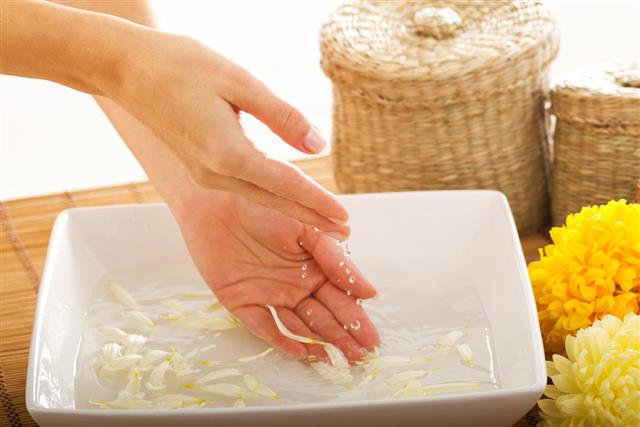
The best way to prevent biological contamination is by adopting proper hand washing techniques. Although, the hands cannot be kept germ-free all the time, frequent washing will prevent transmission of various viruses and bacteria.
‘Hand washing is considered the single most important means of preventing the spread of infection’ – Centers for Disease Control and Prevention
Most of the diseases are caused by germs carried on the hands. 99% of the spread of germs traveling through droplets can be prevented by proper hand washing. People using public restrooms are susceptible to being infected by germs left behind by people who fail to practice good hand hygiene. Moreover, germs can also be picked up while handling library material, common keyboards, etc. Every individual needs to wash his or her hands properly, to reduce disease transmission. Hand washing techniques involve washing of the hands with soap and water or an alcohol-based hand sanitizer.
Washing With Soap and Water
☞ Turn on the tap and allow running water to wet the hands and wrists. While using a public restroom, one should consider that the faucets are contaminated, thus one should turn on the tap by using a paper towel.
☞ Use a soap bar or liquid soap and apply soap to the hands. Soaps are excellent cleansing agents and work well to remove the dirt. The soap should be worked into a lather.
☞ For at least 15-20 seconds rub the hands vigorously together. It is this friction, along with soap and water, that helps wash off the pathogens.
☞ Scrub the hands thoroughly, including the back of the hands, between the fingers, around the cuticles and under the fingernails and wrists.
☞ Under running water, rinse the hands well. The running water carries away the debris and dirt from the hands. While rinsing point the fingers downwards, thereby allowing the water to drip downwards instead of moving towards the elbows and contaminating it.
☞ With a clean towel or disposable paper towel, dry the hands. If using a public restroom, a paper towel should be used to turn the faucet off.
☞ Soap can become a breeding ground for microorganisms, thus one must thoroughly clean soap dispensers before refilling them with fresh liquid soap.
Washing With Alcohol-Based Hand Sanitizer
When soap and water are not available, alcohol-based hand sanitizers prove to be an excellent alternative. In fact, these hand sanitizers are more effective in killing viruses and bacteria as compared to soap and water, which only wash them off. Hand sanitizers can help prevent skin dryness, but some of them may lack alcohol content and are therefore not recommended. Only the alcohol-based ones should be used. Washing the hands with a sanitizer simply requires the application of about half a teaspoon of hand sanitizer on the hand and rubbing the hands together till the hands are dry. The hand sanitizer should cover all the surfaces of the hands. For visibly dirty and soiled hands, soap and water is needed.
Dos and Don’ts of Hand Washing
✗ Never touch the sink, while washing your hands, because the sink is contaminated with microorganisms.
✗ Never touch the restroom knob or handle after washing your hands. You will contaminate them again. Use a paper towel to open the door.
✓ Always remove rings and bracelets before washing your hands.
✓ Always use disposable paper towels in public restrooms. Towels house microorganisms and will only pass germs. Even at home, avoid drying your hands on the kitchen towel.
✗ Never let soapy water run down your wrists during hand washing, because it takes germs along with it and smears them on your forearms. Point your hands downwards while washing them.
When Must I Wash My Hands?
- After using the restroom
- After coming from school, playground, workplace, etc.
- Before eating
- After handling garbage
- After touching animals and their waste
- After coughing, sneezing or blowing the nose
- Before, during and after preparing food
- Before and after treating wounds and cuts
- Before and after meeting an injured or sick person
- Before touching a baby
- After changing a diaper
- Before removing or inserting contact lenses
- After handling money
- After driving
- Whenever hands are visibly dirty
The combination of rubbing the hands thoroughly with regular soap and water and rinsing them prevents the transmission of bacteria and viruses. Using pre-moistened towelettes for cleaning the hands cannot be termed as proper hand washing. They cannot be used as substitutes for soap and water. Thus, be wise and wash your hands thoroughly to maintain proper hygiene.









